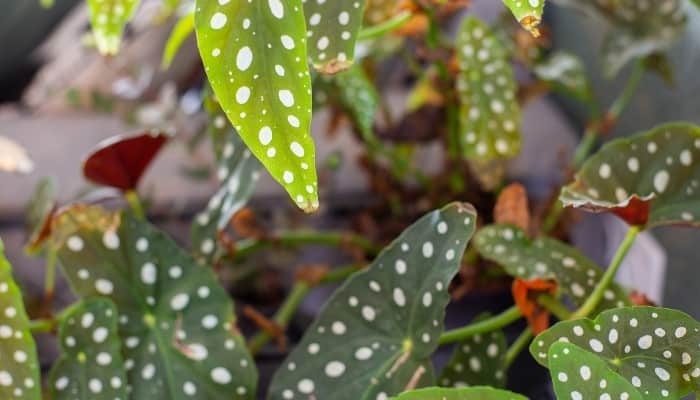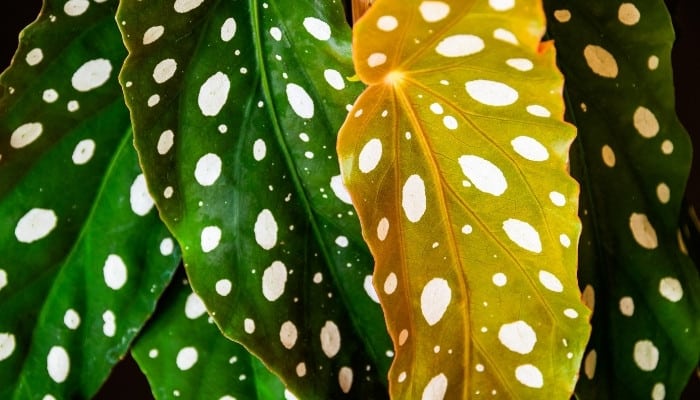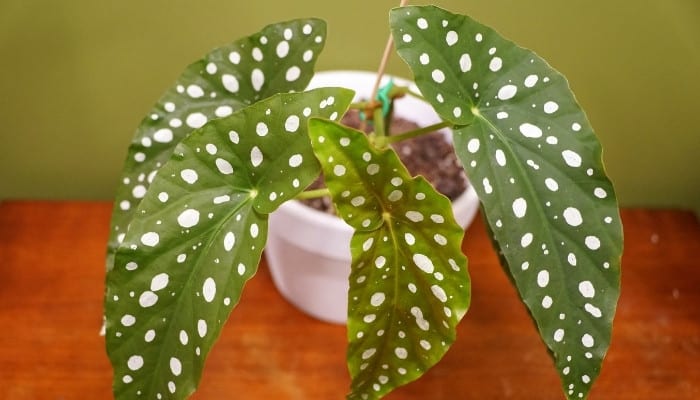Polka dot begonia, scientifically known as Begonia maculata, is an exciting and unusual plant that thrives in both indoor and outdoor environments.
They don’t require much pampering, they look great, and they are super easy to clone to make extras as well.
How do you care for a polka dot begonia? Polka dot begonias require bright, indirect light and fast-draining soil that retains plenty of moisture. Water every few days when it’s hot and every week or two when it’s cold, and maintain 50% humidity and temperatures between 65°F and 85°F. Fertilize every 2-4 weeks.
Read on below and discover everything you need to know to get started with growing and caring for your polka dot begonia today!
Polka Dot Begonia Care Guidelines
The polka dot begonia is a relatively easy plant to care for once you know what you’re in for.
Below, we discuss the specific guidelines in detail for growing and caring for happy and healthy polka dot begonias.
Polka Dot Begonia Care at a Glance
Ideal Soil for Polka Dot Begonia
The polka dot begonia prefers a soil that drains well, such as a light houseplant mix or palm mix.
These types of soil typically contain perlite, sand, or clay to help retain moisture while draining quickly and thoroughly.
Polka Dot Begonia Lighting Needs
Polka dot begonias enjoy a lot of light. That said, they thrive the most in bright, indirect light.
Avoid exposing the plant to direct sunlight at all costs, as it may zap your plant and kill it.
Polka Dot Begonia Water Requirements
The polka dot begonia plant requires a decent amount of water, but they are prone to rot, so don’t overdo it.
Use either your finger or a moisture meter (this sturdy one is just right and inexpensive), and check your plant’s soil regularly.
Add water when it is completely dry. In the summer, that may be every three to five days. In the winter, it may be every 10 to 15 days.
Temperature Ranges & Humidity Levels for Polka Dot Begonia
Polka dot begonias require a temperature range of 65°F to 85°F. As far as humidity is concerned, they prefer a level of 50% humidity or higher.
For this reason, the polka dot begonia plant is much easier to grow indoors than outdoors because you have more control over the environment, including temp and humidity levels.
Fertilizing Polka Dot Begonia
While the plant is actively growing, you may fertilize it every two to four weeks.
Use an all-purpose liquid fertilizer for houseplants (I use this organic one and love it) when you do so.
The fertilization process is as easy as adding nutrients into the water and watering the plant as you normally do.
Polka Dot Begonia Propagation
This plant is extremely easy to propagate. Simply take a 4-inch or 5-inch cutting and stick it in a glass or jar of water.
Keep the water topped off and wait for new white roots to shoot out before replanting. Make sure to place the cutting (and water) somewhere with plenty of bright, indirect light.
How Big Does a Polka Dot Begonia Get?
The polka dot begonia starts off small and ends up growing up to an impressive 4 feet tall. Grown indoors, they may not reach their maximum height, however.
How Long Do Polka Dot Begonias Live?
Polka dot begonias don’t live awfully long compared to many houseplants; on average they’ll last for approximately three years.
Even with the utmost proper care, polka dot begonias won’t live much longer than two to three years.
Can Polka Dot Begonias Go Outside?
Polka dot begonias can grow outside as well as indoors. When growing outside, polka dot begonias thrive when they receive morning sun and remain in shade the rest of the day.
The evening sun is also suitable with shade early in the day.
Outside, polka dot begonias may require a bit more fertilizer, misting, and attention in general. Also keep in mind that they will require some form of pest control if grown outside.
How Fast Do Polka Dot Begonias Grow?
The polka dot begonia plant grows much quicker than many houseplants – up to 12 inches per season.
That said, the actual rate of growth of the plant depends on its environment, including water, light, temperature, humidity, soil, and other factors.
Are Begonia Maculata Rare?
Begonia maculata, or polka dot begonias, are unquestionably rather exotic houseplants.
However, thanks to modern cultivation techniques and today’s global economy, the plant is not exactly rare anymore, generally speaking.
Begonia Maculata Varieties

There are well over 1,000 species of begonias. Certain varieties of begonia are indeed more rare than others.
The most popular polka dot begonia variety is hands down the Begonia maculata ‘Wightii’.
Polka dot begonia is also known as (or sold as):
- Spotted begonia
- Angel wing begonia
- Clown begonia
- Trout begonia
Is the Polka Dot Begonia the Same as the Angel Wing Begonia?
Depending where you are located, one name may be more commonly used than the other, but angel wing begonia is indeed one and the same as the polka dot begonia.
Both polka dot and angel wing are Begonia maculata.
Do Polka Dot Begonias Bloom?
Polka dot begonias do indeed bloom and flower, typically during the spring and winter seasons.
In order to force your polka dot begonia to bloom, simply increase its light source to medium-high (but not direct).
If your polka dot begonia doesn’t receive enough light during its active growing phases. it won’t flower, or if it does flower, the stem will be too weak to support the bloom, and it will snap.
Are Polka Dot Begonias Toxic?
Polka dot begonia’s aren’t poisonous to humans, pets, or otherwise, generally speaking.
However, their sap is somewhat toxic to humans and pets and may cause some irritation, especially in children or pets that happen to put the plant in their mouth.
Can Polka Dot Begonias Grow in Water?
Not only can polka dot begonias grow in water, they actually thrive in water. Whether growing them hydroponically or aquaponically, they do very well.
Furthermore, using straight water is the best way to propagate polka dot begonias from cuttings.
Do Polka Dot Begonias Like To Be Misted?
Polka dot begonias like moisture and humidity, but they do not like to be misted. Avoid misting your plants as it may lead to fungal issues and even root rot if overwatered.
Despite a common misconception, not all exotic and tropical-looking plants like being spritzed with water. Misting your polka dot begonia is one of the surest ways to destroy it.
When Should I Repot My Polka Dot Begonia?
Your polka dot begonia requires replanting once every year. The best time to repot it is in the early to mid-spring, when it is swinging back into life after being dormant during the winter.
While repotting, don’t forget to use fresh good-draining soil with great water retention.
Repotting your polka dot begonia in the springtime also gives you an opportunity to begin fertilizing it for the year.
How Do You Make Polka Dot Begonias Bushy?
Making your polka dot begonias bushy is entirely too easy; simply pinch a quarter of an inch or so off of the top of the plant. Once you pinch/prune it, it’ll begin growing outward.
Repeat the pinching process with new shoots and you’ll have a huge polka dot begonia bush before you know it.
Polka Dot Begonia Common Problems

The polka dot begonia is a gorgeous and exotic-looking plant that isn’t all that hard to grow and care for. That said, there are several common problems that you should be aware of.
Below, we discuss the most common problems with polka dot begonias as well as solutions for each one.
White Mildew
Perhaps the most common problem with polka dot begonias is the occurrence of white mildew. The number one reason for this fungal issue is misting your plant’s leaves.
Solution
Remove infected leaves and avoid misting your plant in the future. Polka dot begonias do not want to be misted, especially indoors.
From time to time, if growing outside, they may need it (but only rarely, when it is extremely dry outside).
Yellow Leaves
Polka dot begonias are known for developing yellow leaves when they’ve been overwatered.
In this case, the real issue could be that the container it’s growing in doesn’t have good drainage.
Yellow leaves may also be an indicator that the plant has low nutrient levels.
Solution
If your begonia has yellow leaves, you may need to repot it immediately due to the soil and roots being waterlogged.
If you don’t act soon enough, you may have root rot on your hands as well as yellow leaves.
Brown Leaf Tips
The most common reason for brown leaf tips developing on polka dot begonias is underwatering.
That said, brown leaf tips may show up due to sharp increases in temperature and prolonged exposure to high temperatures.
Solution
The most straightforward way to treat your begonia for brown leaf tips is to increase the amount of water you’re giving it or increasing the frequency of your waterings.
Leaf Drop
Temperature shock and overwatering are the main reasons behind polka dot begonias dropping their leaves. Thankfully, it’s an easy problem to solve.
Solution
Perform routine moisture level checks in order to help avoid overwatering your plant.
In addition, consider keeping it away from heaters and air conditioners. That way it is at a stable temperature and less likely to go into shock and drop leaves.
Root Rot
This disease is caused by constant overwatering or using the wrong type of soil for your polka dot begonia. Misting may also help lead your plant to develop root rot.
Solution
Make sure that your polka dot begonia is potted with rich soil that drains well and also has high water retention.
No Blooms/Poor Blooms
A lack of bright light causes begonias to skip over their blooming phase or makes their stems so weak that they will break under the weight of the blooms.
Solution
Place your plant somewhere where it receives plenty of bright light from the outdoors. Just make sure that the light isn’t direct or your plant will die rather than develop blooms.
We explain exactly what bright, indirect light is in this article if you’re unsure what to look for.
Whiteflies and Mealybugs
Mealybugs and whiteflies are among the most common pests that end up infecting begonias.
They are a real hassle because many typical pest control methods aren’t effective against them at all.
These critters will get all over your begonias, especially if they are overwatered or misted, and slowly suck the life out of them.
Solution
There are a few different approaches for dealing with mealybugs and whiteflies on polka dot begonias.
The first one is simply watering your plants properly and avoiding misting and overwatering (as well as using the correct type of soil).
The second solution is using powerful organic pest control techniques, like sprinkling cinnamon or spraying lemon juice and white vinegar.
Finally, ladybugs may also be released on the plants to eat the pests.
A Final Word About Polka Dot Begonia Care
Polka dot begonias are easy enough to grow and care for, but they do require a bit more of your attention to thrive.
As long as you follow the guidelines presented here in this article, you’ll do just fine!
With that in mind, feel free to refer back to this guide as often as needed while you’re learning how to care for your new polka dot begonias!

